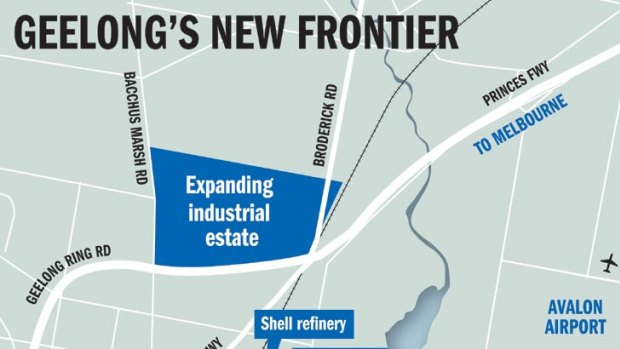This was published 13 years ago
A ring of confidence
The City of Greater Geelong hopes an industrial estate will bring thousands of jobs, writes Philip Hopkins.
By Philip Hopkins
THE Geelong Ring Road could drive a new era in economic growth by providing access to a 500-hectare industrial zone in the city's north.
The ring road forms the southern boundary of the new industrial estate, dubbed the Geelong Ring Road Employment Precinct. The first stage of building is only weeks from completion.

Geelong's new frontier.
About a third of the industrial estate is in use, but the remaining two-thirds are undeveloped.
Investment from Melbourne is clearly in the sights of the City of Greater Geelong, which owns half the empty area and is driving the project.
''The purchase price of the land and the rates will be cheaper than in Melbourne,'' the city's chief executive, Stephen Griffin, told BusinessDay.
The precinct ''will have access to road, rail, sea and air'', said deputy mayor Cr Cameron Granger, whose portfolio includes rural and regional affairs.
There is not yet direct access from the ring road to the industrial estate, but on and off-ramps to the Princes Freeway are likely to be built at Broderick Road, along the estate's eastern boundary.
The precinct is 35 minutes from the Western Ring Road, which links the Princes Freeway to the Tullamarine (Calder) Freeway and Hume Freeway to New South Wales.
Avalon Airport is 12 kilometres away, and the Buildev Group plans to build a depot for exchanging freight between road and rail on the freeway opposite Avalon.
The main rail line runs past the precinct, and the feasibility of re-establishing a rail spur to the industrial estate - a private spur previously operated into the precinct - is being investigated.
The council hopes the industrial estate will also serve the Port of Geelong, which is expected to expand and is only a few kilometres away.
The new state government has ordered a study into whether the port could play a part in the import and export of cars to ease the pressure on the Port of Melbourne.
The council is keen for the precinct to be a source of jobs, especially for the northern parts of Geelong such as Norlane and Corio.
In the long term, Mr Griffin said, the aim was to create 10,000 jobs directly on the estate, with the possibility that 22,000 other new jobs would later be created.
Mr Griffin said the council was overseeing the development of much of the 500-hectare site because of its responsibility for local employment.
A developer that bought land sold by the council could leave the site unused for years.
Mr Griffin said it would cost $80 million to immediately install all the necessary infrastructure, so the work was being done in stages.
''It will be substantially self-funding, eventually, over 10 years, after we have done the upfront investment,'' he said.
Ron Hill, the council's project manager of engineering services, is overseeing the infrastructure work - upgrading the roads, installing piping and creating settlement ponds that will take stormwater and cater for a one-in-100-year flood.
The work on the industrial estate includes taking soil from the settlement pond sites to fill in lower parts of the estate. This soil will be compacted to create sites for future factories.
Bill Johnsen, Geelong's senior economic development officer, said all planned roads would have fibre-optic cabling.
''Any business, such as one that wants to use robotics, will be able to connect into it,'' Mr Johnsen told BusinessDay.
Allotments in the estate vary from 4000 square metres to five hectares.
One private developer, Broderick Road Industries, has sold the first stage of its development land. Industries now using the site include fibreglass maker RPC and Thornton steel fabrication.